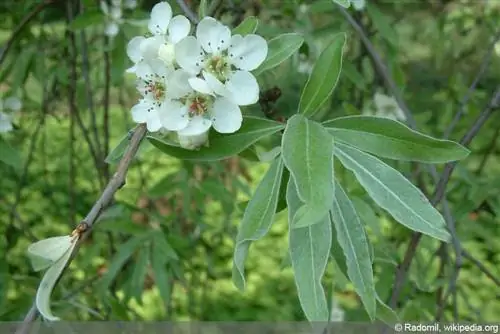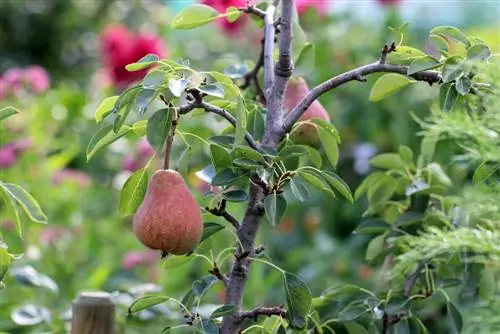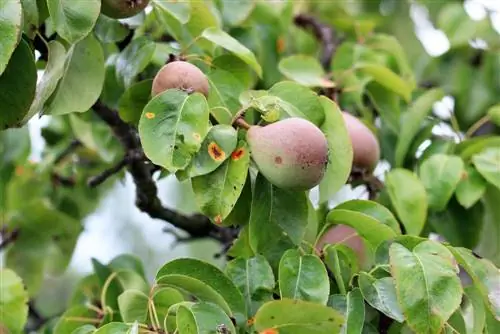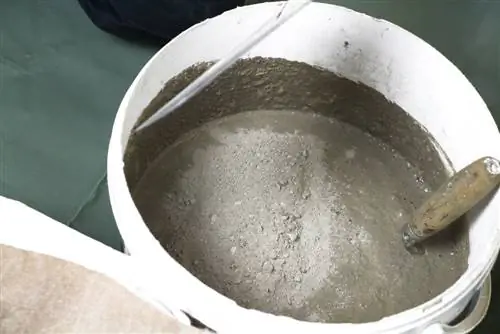- Author admin [email protected].
- Public 2023-12-17 03:39.
- Last modified 2025-01-24 12:45.
The name says it all: an ornamental pear is primarily used for decoration. It can be used to create wonderful visual accents in the garden. In the case of the so-called willow-leaved pear, one of the most beautiful ornamental pear varieties, it begins with a particularly unspoiled trunk that is reminiscent of an olive tree. In spring, the ornamental pear impresses with its magnificent display of flowers. And in autumn it offers a real fireworks display of colorful leaves. Of course, it also bears fruit that you can of course eat. However, the taste and yield are limited.
Varieties
The ornamental pear is one of the so-called ornamental trees. It is available as a normal-sized tree, as a dwarf tree and as a perennial. Of course, the most impressive are those trees that are in no way inferior to a conventional fruit tree. Various varieties are now available for our latitudes. The four most common ones are as follows:
Beech Hill, which can reach a crown width of up to five meters and grows relatively quickly, namely around half a meter per year, without requiring much care
Chanticleer, a true giant among ornamental pears that can reach an impressive height of up to ten meters and fascinates in early summer with its brilliant white flowers
Pyrus caucasica, an ornamental pear that particularly scores with its straight, absolutely vertically upward-growing trunk
Willow-leaved pear, which is a great alternative to olive trees, as its trunk is at least as gnarled and overgrown
The various varieties of ornamental pears that are now available in stores are not only suitable for the garden, but are also often planted in public places and along streets. The fruits of all varieties are edible.
Tip:
The fruits of ornamental pear trees taste much better if you can them and not just eat them raw.
Location and soil

The ornamental pear is primarily a fruit tree. Like all other fruit trees, it loves a location that is as sunny as possible. The tree also copes excellently with direct sunlight and high heat. In return, it makes sense that it is also relatively insensitive to cold and especially frost. The soil should of course be nutrient-rich and allow water to drain easily.
Note:
The ornamental pear naturally needs water to grow, but it doesn't like it moist. If the soil is too clayey, we strongly recommend mixing it well with sand before planting the tree. When choosing a location, you should definitely keep in mind that ornamental pear trees grow very large and can form a lush crown. You therefore need space. In addition, it is also a good idea to choose the location based on visual aspects. An ornamental pear usually looks better in the background than when it is the focus. Otherwise, the direct proximity to other fruit trees does not pose a problem.
Planting
In most cases, the ornamental pear is planted as a young tree from a gardening store. As a rule, it is already so old that it can easily withstand frost. So it should be hardy from the start. Theoretically, the ornamental pear can be planted all year round. But the best time to plant is undoubtedly autumn. To plant, dig a hole with a spade into which the tree's root ball fits easily. It is important that the soil is as loose as possible. Ornamental pears have very deep roots.
A loose, not too clayey soil not only ensures that excess water drains away and prevents waterlogging, but also makes it easier for roots to take root. The planting hole is filled with the previously excavated soil and some compost. The earth is pressed down so that the tree has a firm footing. A plant support that is tied to the side of the trunk and inserted into the ground provides additional support at the beginning. Then you have to water.
Care
Ornamental pears are extremely undemanding and undemanding fruit trees. If the location and soil conditions are suitable, they hardly require any care. In any case, they feel most comfortable when they are left largely alone and can simply grow along. The only important thing is that the ornamental pear is fertilized regularly. The reason for this simply has to do with the fact that this type of tree is relatively susceptible to so-called fire blight. This is especially true for the widespread variety Pyrus caucasica. Regular fertilization gives the tree the nutrients it needs to remain resistant to the disease.
Cut
As already mentioned, ornamental pear trees thrive best when left largely alone. Pruning is therefore not necessary. Practically all ornamental pear varieties form a lush and widely branched crown even without pruning. If necessary, it is advisable to thin out the crown a little to make room for new shoots and, if necessary, to remove any water shoots. However, if you want to achieve very special optical effects, you can literally cut the decorative pear into shape. Whether you want to do that is of course a matter of taste. Basically, cutting should only be done towards the end of winter, otherwise there is a risk of massively weakening the tree.
Seasons

Apart from the winter months, the ornamental pear is a real feast for the eyes at any time of the year. This is exactly where its special appeal lies. Their reason for being is not to carry as many pears as possible, but rather to shine visually. This becomes particularly clear after the harvest in autumn. Practically all varieties enchant with the diverse play of colors that their leaves now celebrate. It is at least as fascinating as the lush blossoms in spring. Of course, this is especially true if several ornamental pears have been planted in a small group. If these are different varieties, the coloring of the leaves will usually vary subtly.
Combinations
The dwarf pear harmonizes very well with other fruit trees and shrubs. Especially by combining them with certain shrubs, impressive visual results can be achieved that are hard to get enough of. The so-called silver diamond, for example, is ideal for this and can reach a height of up to 70 centimeters. Ground cover plants such as the woolly zest or the cushion silver rue are also something of a perfect addition to dwarf pear trees. Ultimately, you can also combine them wonderfully with various steppe plants or grasses.
In short:
The dwarf pear is the perfect tree for anyone who wants to design their garden primarily from an aesthetic point of view and who does not attach great importance to the yield. If you want to fully express your creativity in the garden, the dwarf pear is undoubtedly the best choice. And because it requires relatively little work compared to many other plants, the joy of using it is probably even greater.






